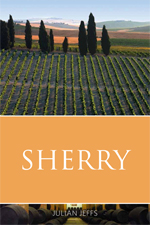Sherry
| Title of book: | Sherry |
| Author: | Julian Jeffs |
| Publisher: | Infinite Ideas |
| Publication date: | 2015 |
| ISBN | 978 1 908984 29 6 |
| Pages: | 260 |
| Price: | £35.00 (hardback) |
 Julian Jeffs wrote the first edition of this book in 1961. No-one is better placed to comment on the huge changes in the sherry industry over that time.
Julian Jeffs wrote the first edition of this book in 1961. No-one is better placed to comment on the huge changes in the sherry industry over that time.
I’m not usually too bothered to read about the origins of wine or a wine, but Jeffs’ engaging snapshot condensed some thousand years into just a few pages of eminently readable stuff about occupations and invasions … from the Romans to the Visigoths via the Vandals, then the Moors and the Berbers by AD700s, before becoming Christian sometime in the latter 1200s. And it seems fitting to have this retrospective for such an historic wine as sherry. We learn that viticulture survived all those changes in power, and indeed, sherry was likely to have already been a fortified wine by the 1300s, a blend of Moors’ distilled alcohol and wine.
Jeffs traces trade links with English merchants to the late 1400s, which had become firm trading routes by the 1500s. Enter ‘sherry sack’ by the reign of Elizabeth I, a drink of increasing popularity in spite of political battling between England and Spain during Elizabeth’s reign, 1558-1603. By the end of the 1600s the name sherry had largely replaced sack.
If history is less your thing, these enticing chapters can be skipped … though with a 21st century trend for provenance and authenticity and heritage, these same chapters illustrate in spades those attributes for sherry. These same chapters introduce us to the famed old family names and brands, Valdespino being one of the oldest, with British names following in the latter part of the 18th century, including Sandeman and Harvey. In part I feel like I’m reading something of an adventure story.
We learn of peaks and troughs in supply and demand: the sherry trade reached a peak in the 1870s and by turn of 20th century it had slumped, already being regarded as a tipple of elderly womenfolk, a view that also held sway at the other end of that century. Another peak in the early 1970s, then another decline in the 80s. As with other wine regions, overproduction provided a catalyst for reform. Jeffs informs us that the vineyard area almost doubled during the 70s, and as recently as 2013 it had retrenched to under 7,000 ha, which the author suggests may finally be in balance.
The book is additionally full of wonderful snippets of related and extraneous information, especially in those root-foraging chapters. I never knew William Gladstone’s 1861 ‘single bottle’ act allowed the sale of single bottles, thus creating off-licences and allowing supermarkets access to the wine trade. Nor that UK poet laureates are given a butt of sack.
Vignettes from Jeffs’ early visits from the 1950s have a wonderful, other-worldliness to them, and his descriptions of pre-technical age processes appear charmingly quaint through 21st century tinted spectacles, but show the important degree of (r)evolution in winemaking, in just the last 30-odd years.
A dearth of pictures in a wine book is always disappointing, especially when vineyards are described so picturesquely, and bodegas can be imposing and grand, partly to better mature the wine.
If you’re looking for quick and dirty sherry facts this is perhaps not the book for you. Which is not to say the facts are not here, far from it, just that a more meandering read is required to spot the gems. The book contains a huge amount of detailed description, and personal insight garnered over decades, charting the known origins and history of the special beverage that is sherry, in all its myriad of styles. Start here for your own personal journey into this unique wine.



